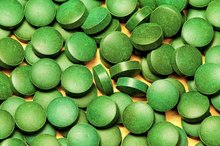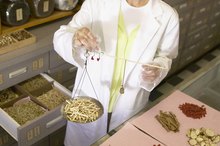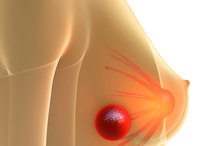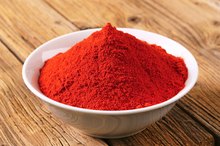What does fact checked mean?
At Healthfully, we strive to deliver objective content that is accurate and up-to-date. Our team periodically reviews articles in order to ensure content quality. The sources cited below consist of evidence from peer-reviewed journals, prominent medical organizations, academic associations, and government data.
- Oncogene: Capsaicin Causes Cell-Cycle Arrest and Apoptosis in ER-Positive and -Negative Breast Cancer Cells by Modulating the EGFR/HER-2 Pathway; N.H. Thoennissen et al.; January 2010
- Oncogene: Capsaicin Causes Cell-Cycle Arrest and Apoptosis in ER-Positive and -Negative Breast Cancer Cells by Modulating the EGFR/HER-2 Pathway; N.H. Thoennissen et al.; January 2010
The information contained on this site is for informational purposes only, and should not be used as a substitute for the advice of a professional health care provider. Please check with the appropriate physician regarding health questions and concerns. Although we strive to deliver accurate and up-to-date information, no guarantee to that effect is made.
Cayenne Pepper, Cancer & Tumors
Cayenne pepper appears to effect different cancers in different ways, and the nature of the effect depends on the stage of the cancer. Cayenne pepper contains capsaicin; traditional medicine employs this compound as an herbal remedy for the treatment of numerous chronic diseases, including cancer. At present, research into the role of cayenne pepper in cancer treatment delivers mixed results: Some research suggests that capsaicin promotes tumor growth while other studies show that capsaicin facilitates the death of cancer cells.
If you are experiencing serious medical symptoms, seek emergency treatment immediately.
Capsaicin
Capsaicin goes by a variety of common names, including capsicum, cayenne and conoids. According to the American Cancer Society, most human studies into capsaicin focus mainly on its effectiveness as an oral treatment for pain relief in cancer patients with side effects from chemotherapy and radiation therapy 1. While capsaicin shows promise in some laboratory and animal studies, results from human studies remain unavailable. Therefore, as of 2011 the American Cancer Society does not endorse capsaicin as a cancer treatment 1.
Apoptosis
Oldenlandia Diffusa Side Effects
Learn More
Capsaicin demonstrates the ability to inhibit the growth of cancer cells; research suggests that the compound promotes apoptosis – the death of cancer cells. In 2010 researchers from the UCLA School of Medicine studied breast cancer cells and found that capsaicin not only retarded their growth and arrested their ability to travel, but also increased the degree of apoptosis. The results of this research were published in the January 2010 issue of the journal “Oncogene.”
Co-Carcinogen
Capsaicin also appears to promote the growth of tumors, particularly in skin cancer cases; however, as of 2011 the research available to prove this claim exists only in animal studies. Researchers from the University of Minnesota examined the impact of capsaicin in skin cancer tumors and found it to increase both the number and size of skin cancer tumors. The results of this study were published in the September 2010 issue of the journal “Cancer Research.”
Prostate Cancer
The Benefits of Habanero Pepper & Cayenne
Learn More
According to the American Cancer Society, the capsaicin in cayenne pepper demonstrates the ability to arrest the growth of prostate cancer cells 1. However, while encouraging, research that supports cayenne pepper as a treatment for prostate cancer exists only in laboratory and animal studies as of 2011. Researchers are investigating the potential use of cayenne pepper to treat cancer. However, human studies are necessary to determine if the benefits of capsaicin extend to humans.
- According to the American Cancer Society, the capsaicin in cayenne pepper demonstrates the ability to arrest the growth of prostate cancer cells 1.
- However, while encouraging, research that supports cayenne pepper as a treatment for prostate cancer exists only in laboratory and animal studies as of 2011.
Related Articles
References
- American Cancer Society: Capsicum; November 2008
- Oncogene: Capsaicin Causes Cell-Cycle Arrest and Apoptosis in ER-Positive and -Negative Breast Cancer Cells by Modulating the EGFR/HER-2 Pathway; N.H. Thoennissen et al.; January 2010
- Cancer Research: Cocarcinogenic Effect of Capsaicin Involves Activation of EGFR Signaling but Not TRPV1; Mun Kyung Hwang et al.; September 2010
- Sharma SK, Vij AS, Sharma M. Mechanisms and clinical uses of capsaicin. Eur J Pharmacol. 2013;720(1-3):55-62. doi:10.1016/j.ejphar.2013.10.053
- U.S. Food and Drug Administration. Draft Guidance on Capsaicin. Silver Spring, Maryland; issued October 2018.
- Gagnier JJ, Van tulder M, Berman B, Bombardier C. Herbal medicine for low back pain. Cochrane Database Syst Rev. 2006;(2):CD004504. doi:10.1002/14651858.CD004504.pub3
- Laslett LL, Jones G. Capsaicin for osteoarthritis pain. Prog Drug Res. 2014;68:277-91.
- Babbar S, Marier JF, Mouksassi MS, et al. Pharmacokinetic analysis of capsaicin after topical administration of a high-concentration capsaicin patch to patients with peripheral neuropathic pain. Ther Drug Monit. 2009;31(4):502-10. doi:10.1097/FTD.0b013e3181a8b200
- U.S. Food and Drug Administration. Qutenza (capsaicin) NDA #022395. Drug Approval Package.
- Mccarty MF, Dinicolantonio JJ, O'keefe JH. Capsaicin may have important potential for promoting vascular and metabolic health. Open Heart. 2015;2(1):e000262. doi:10.1136/openhrt-2015-000262
- Jones VM, Moore KA, Peterson DM. Capsaicin 8% topical patch (Qutenza)--a review of the evidence. J Pain Palliat Care Pharmacother. 2011;25(1):32-41. doi:10.3109/15360288.2010.547561
- Qutenza. Patient's Guide.
- Anand, P. and Bley, K. Topical capsaicin for pain management: therapeutic potential and mechanisms of action of the new high-concentration capsaicin 8% patch. Br J Anaesth. 2011 Oct;107(4);490-502. DOI: 10.1093/bja/aer260.
- Babbar, S.; Marier, J.; Mouksassi, M. et al. Pharmacokinetic analysis of capsaicin after topical administration of a high-concentration capsaicin patch to patients with peripheral neuropathic pain. Ther Drug Monit. 2009 Aug;31(4):502-10. DOI: 10.1097/FTD.0b013e3181a8b200.
- Gagnier, J.; van Tulder, M.; Berman, B. et al. Herbal medicine for low back pain. Cochrane Data Syst Rev. 2006 Apr 19;(2): CD004504. DOI: 10.1002/14651858.CD004504.pub3.
- U.S. Food and Drug Administration. Draft Guidance on Capsaicin. Silver Spring, Maryland; issued October 2018.
Resources
Writer Bio
Emma Cale has been writing professionally since 2000. Her work has appeared in “NOW Magazine,” “HOUR Magazine” and the “Globe and Mail.” Cale holds a Bachelor of Arts in English from the University of Windsor and advanced writing certificates from the Canadian Film Centre and the National Theatre School of Canada.








